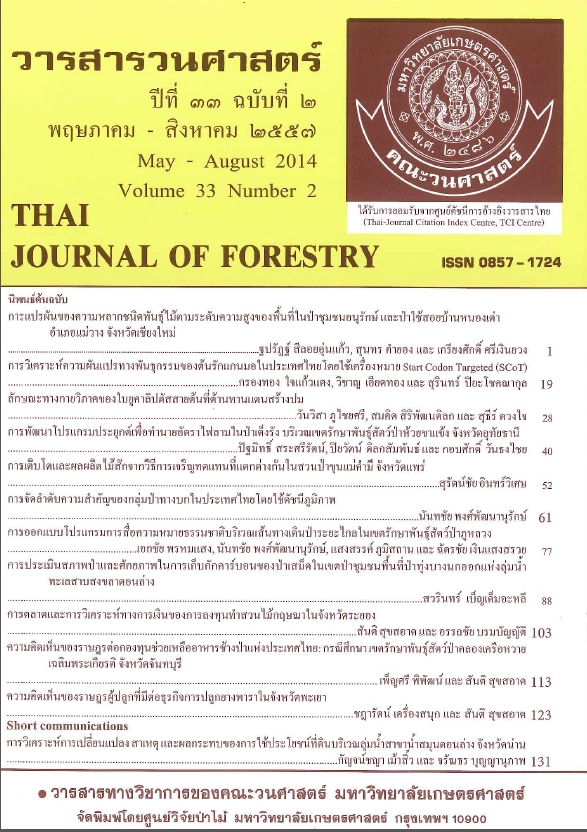การวิเคราะห์การเปลี่ยนแปลง สาเหตุ และผลกระทบของการใช้ประโยชน์ที่ดิน บริเวณลุ่มน้ำสาขาน้ำสมุนตอนล่าง จังหวัดน่าน
Main Article Content
บทคัดย่อ
การเปลี่ยนแปลงวิถีเกษตรกรรมในปัจจุบันได้ส่งผลให้เกิดปัญหาการใช้ที่ดินไม่เหมาะสมอย่างรุนแรงเพิ่มมากขึ้น ขณะที่ข้อมูลทางวิชาการที่จะค้นหาถึงสาเหตุ ปัจจัย และแรงขับเคลื่อนที่สำคัญอันเป็นเหตุจูงใจที่ทำให้เกษตรกรในท้องถิ่นเปลี่ยนแปลงวิถีเกษตรกรรมยังมีไม่มากนัก ดังนั้น การศึกษาครั้งนี้มีวัตถุประสงค์เพื่อวิเคราะห์ลักษณะของการเปลี่ยนแปลงการใช้ที่ดิน และศึกษาสาเหตุและผลกระทบของการเปลี่ยนแปลงการใช้ที่ดินในพื้นที่บริเวณลุ่มน้ำสาขาน้ำสมุนตอนล่าง จังหวัดน่าน ผลการวิเคราะห์การเปลี่ยนแปลงการใช้ที่ดินได้ถูกนำไปวิเคราะห์ร่วมกับ ข้อมูลการเปลี่ยนแปลงวิถีเกษตรกรรมที่ได้จากการประชุมสนทนากลุ่มและการสัมภาษณ์เชิงลึกของกลุ่มผู้ให้ข้อมูลหลัก เพื่อนำมาวิเคราะห์สาเหตุที่แท้จริงและผลกระทบของการเปลี่ยนแปลงการใช้ที่ดินด้วยเทคนิคแผนภูมิ Ishikawa diagram ผลการศึกษา พบว่า พื้นที่ป่าไม้มีเนื้อที่ลดลงอย่างต่อเนื่อง โดยสาเหตุหลักมาจากการถูกบุกรุกและจับจองพื้นที่ป่าไม้เพื่อทำการเกษตร โดยเฉพาะการทำไร่ข้าวโพดเลี้ยงสัตว์ ขณะที่สวนยางพารามีเพิ่มขึ้นอย่างรวดเร็ว การประกอบกิจกรรมทางเกษตรเศรษฐกิจของชุมชนท้องถิ่นและนโยบายการส่งเสริมภาคเกษตรกรรมจากหน่วยงานของรัฐ เป็นแรงขับเคลื่อนที่สำคัญของการเปลี่ยนแปลงการใช้ที่ดิน เนื่องจากเกษตรกรส่วนใหญ่เน้นการทำเกษตรกรรมเชิงพาณิชย์เพื่อเพิ่มฐานะทางสังคม รวมถึงการเข้าถึงแหล่งทุนที่สะดวกขึ้น ส่งผลให้เกิดการขยายตัวของพื้นที่ของเกษตรกรรมและรูปแบบของการทำเกษตรกรรมในพื้นที่ศึกษา นอกจากนี้ ผลกระทบด้านต่างๆ ที่เกิดขึ้นจากการใช้ที่ดิน โดยเฉพาะการใช้ประโยชน์จากทรัพยากรที่ดินและป่าไม้บนพื้นที่แหล่งต้นน้ำ อาจมีอิทธิพลต่อการพัฒนาที่ยั่งยืนของท้องถิ่นได้ในอนาคต
คำสำคัญ: แรงขับเคลื่อน การเปลี่ยนแปลงการใช้ที่ดิน การใช้ที่ดินไม่เหมาะสม ลุ่มน้ำน่าน การวิเคราะห์สาเหตุที่แท้จริง
Downloads
Article Details

อนุญาตภายใต้เงื่อนไข Creative Commons Attribution-NonCommercial-NoDerivatives 4.0 International License.
ข้าพเจ้าและผู้เขียนร่วม (ถ้ามี) ขอรับรองว่า ต้นฉบับที่เสนอมานี้ยังไม่เคยได้รับการตีพิมพ์และไม่ได้อยู่ในระหว่างกระบวนการพิจารณาตีพิมพ์ลงในวารสารหรือสิ่งตีพิมพ์อื่นใด ข้าพเจ้าและผู้เขียนร่วม (ถ้ามี) ยอมรับหลักเกณฑ์และเงื่อนไขการพิจารณาต้นฉบับ ทั้งยินยอมให้กองบรรณาธิการมีสิทธิ์พิจารณาและตรวจแก้ต้นฉบับได้ตามที่เห็นสมควร พร้อมนี้ขอมอบลิขสิทธิ์ผลงานที่ได้รับการตีพิมพ์ให้แก่วารสารวนศาสตร์ คณะวนศาสตร์ มหาวิทยาลัยเกษตรศาสตร์ กรณีมีการฟ้องร้องเรื่องการละเมิดลิขสิทธิ์เกี่ยวกับภาพ กราฟ ข้อความส่วนใดส่วนหนึ่ง หรือ ข้อคิดเห็นที่ปรากฏในผลงาน ให้เป็นความรับผิดชอบของข้าพเจ้าและผู้เขียนร่วม (ถ้ามี) แต่เพียงฝ่ายเดียว และหากข้าพเจ้าและผู้เขียนร่วม (ถ้ามี) ประสงค์ถอนบทความในระหว่างกระบวนการพิจารณาของทางวารสาร ข้าพเจ้าและผู้เขียนร่วม (ถ้ามี) ยินดีรับผิดชอบค่าใช้จ่ายทั้งหมดที่เกิดขึ้นในกระบวนการพิจารณาบทความนั้น”


